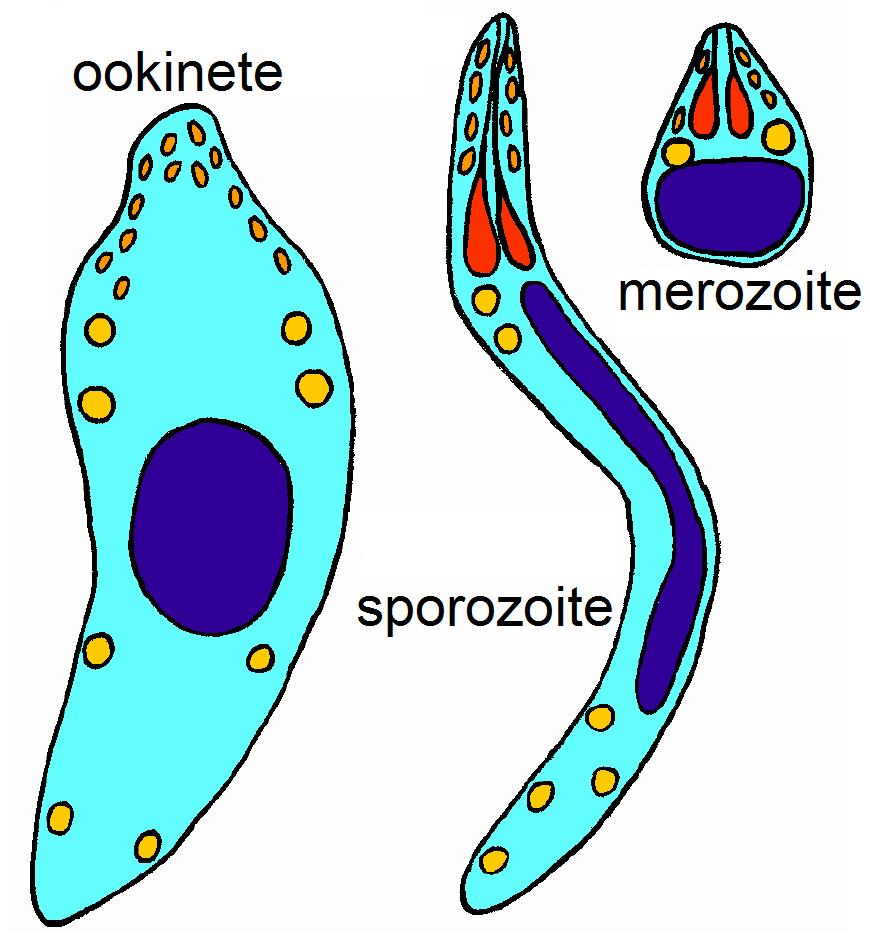Tachyzoite on:
[Wikipedia]
[Google]
[Amazon]
Apicomplexans, a group of

intracellular parasite
Intracellular parasites are microparasites that are capable of growing and reproducing inside the cells of a host.
Types of parasites
There are two main types of intracellular parasites: Facultative and Obligate.
Facultative intracellular para ...
s, have life cycle stages that allow them to survive the wide variety of environments they are exposed to during their complex life cycle. Each stage in the life cycle of an apicomplexan organism is typified by a ''cellular variety'' with a distinct morphology and biochemistry.
Not all apicomplexa develop all the following cellular varieties and division methods. This presentation is intended as an outline of a hypothetical generalised apicomplexan organism.
Methods of asexual replication
Apicomplexans (sporozoans) replicate via ways of multiple fission (also known asschizogony
Fission, in biology, is the division of a single entity into two or more parts and the regeneration of those parts to separate entities resembling the original. The object experiencing fission is usually a cell, but the term may also refer to how ...
). These ways include , and , although the latter is sometimes referred to as schizogony, despite its general meaning.
Merogony is an asexually reproductive process of apicomplexa. After infecting a host cell, a trophozoite ( see glossary below) increases in size while repeatedly replicating its nucleus and other organelles. During this process, the organism is known as a or . Cytokinesis next subdivides the multinucleated schizont into numerous identical daughter cells called merozoites ( see glossary below), which are released into the blood when the host cell ruptures. Organisms whose life cycles rely on this process include '' Theileria'', '' Babesia'', '' Plasmodium'', and '' Toxoplasma gondii.''
Sporogony is a type of sexual and asexual reproduction. It involves karyogamy, the formation of a zygote, which is followed by meiosis and multiple fission. This results in the production of sporozoites.
Other forms of replication include and .
Endodyogeny is a process of asexual reproduction
Asexual reproduction is a type of reproduction that does not involve the fusion of gametes or change in the number of chromosomes. The offspring that arise by asexual reproduction from either unicellular or multicellular organisms inherit the fu ...
, favoured by parasites such as '' Toxoplasma gondii''. It involves an unusual process in which two daughter cells are produced inside a mother cell, which is then consumed by the offspring prior to their separation.
Endopolygeny is the division into several organisms at once by internal budding.
Glossary of cell types

Infectious stages
A (ancient Greek ', seed + ', animal) is the cell form that infects new hosts. In '' Plasmodium'', for instance, the sporozoites are cells that develop in the mosquito's salivary glands, leave the mosquito during a blood meal, and enter liver cells ( hepatocytes), where they multiply. Cells infected with sporozoites eventually burst, releasing merozoites into the bloodstream. Sporozoites are motile and they move bygliding
Gliding is a recreational activity and competitive air sport in which pilots fly unpowered aircraft known as gliders or sailplanes using naturally occurring currents of rising air in the atmosphere to remain airborne. The word ''soaring'' is al ...
.
A (G. ', part f a series
F, or f, is the sixth Letter (alphabet), letter in the Latin alphabet, used in the English alphabet, modern English alphabet, the alphabets of other western European languages and others worldwide. Its name in English is English alphabet#Let ...
+', animal) is the result of merogony that takes place within a host cell. During this stage, the parasite infects the host's cells and then replicates its own nucleus and induces cell segmentation in a form of asexual reproduction. In coccidiosis, merozoites form the first phase of the internal life cycle of coccidian. In the case of '' Plasmodium'', merozoites infect red blood cells and then rapidly reproduce asexually. The red blood cell host is destroyed by this process, which releases many new merozoites that go on to find new blood-borne hosts. Merozoites are motile. Before schizogony
Fission, in biology, is the division of a single entity into two or more parts and the regeneration of those parts to separate entities resembling the original. The object experiencing fission is usually a cell, but the term may also refer to how ...
, the merozoite is also known as the schizozoite.
A ( G. ', partner + ', cell) is a name given to a parasite's gamete-forming cells. A male gametocyte divides to give many flagellated microgamete
{{Short pages monitor
File:Toxoplasmosis life cycle en.svg, Lifecycle of the '' Toxoplasma'' parasite
See also
* Trematode lifecycle stagesReferences
{{reflist Apicomplexa Reproduction